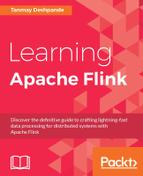Book Description
Discover the definitive guide to crafting lightning-fast data processing for distributed systems with Apache Flink
About This Book
- Build your expertize in processing real-time data with Apache Flink and its ecosystem
- Gain insights into the working of all components of Apache Flink such as FlinkML, Gelly, and Table API filled with real world use cases
- Exploit Apache Flink's capabilities like distributed data streaming, in-memory processing, pipelining and iteration operators to improve performance.
- Solve real world big-data problems with real time in-memory and disk-based processing capabilities of Apache Flink.
Who This Book Is For
Big data developers who are looking to process batch and real-time data on distributed systems. Basic knowledge of Hadoop and big data is assumed. Reasonable knowledge of Java or Scala is expected.
What You Will Learn
- Learn how to build end to end real time analytics projects
- Integrate with existing big data stack and utilize existing infrastructure
- Build predictive analytics applications using FlinkML
- Use graph library to perform graph querying and search.
- Understand Flink's - "Streaming First" architecture to implementing real streaming applications
- Learn Flink Logging and Monitoring best practices in order to efficiently design your data pipelines
- Explore the detailed processes to deploy Flink cluster on Amazon Web Services(AWS) and Google Cloud Platform (GCP).
In Detail
With the advent of massive computer systems, organizations in different domains generate large amounts of data on a real-time basis. The latest entrant to big data processing, Apache Flink, is designed to process continuous streams of data at a lightning fast pace.
This book will be your definitive guide to batch and stream data processing with Apache Flink. The book begins with introducing the Apache Flink ecosystem, setting it up and using the DataSet and DataStream API for processing batch and streaming datasets. Bringing the power of SQL to Flink, this book will then explore the Table API for querying and manipulating data. In the latter half of the book, readers will get to learn the remaining ecosystem of Apache Flink to achieve complex tasks such as event processing, machine learning, and graph processing. The final part of the book would consist of topics such as scaling Flink solutions, performance optimization and integrating Flink with other tools such as ElasticSearch.
Whether you want to dive deeper into Apache Flink, or want to investigate how to get more out of this powerful technology, you'll find everything you need inside.
Style and approach
This book is a comprehensive guide that covers advanced features of the Apache Flink, and communicates them with a practical understanding of the underlying concepts for how, when, and why to use them.
Downloading the example code for this book. You can download the example code files for all Packt books you have purchased from your account at http://www.PacktPub.com. If you purchased this book elsewhere, you can visit http://www.PacktPub.com/support and register to have the code file.
